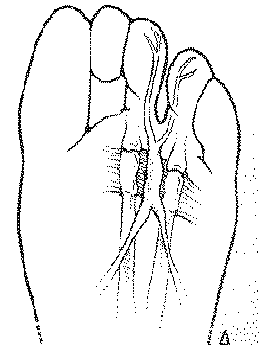| FOOT
DISORDERS -
Morton's Neuroma |
Morton's Neuroma is a pathological condition of
the common digital nerve between the third and fourth metatarsals (third
inter-metatarsal space). The nerve sheath becomes abnormally thickened
with fibrous ("scar") tissue and the nerve fibers eventually deteriorate. This
common digital nerve runs along the bottom (plantar) surface of the foot
and branches to supply sensation to the plantar aspect and tips of the third and
fourth toes. Occasionally, the common digital nerves in the second
inter-metatarsal space is affected. Very rarely the nerve in the first or
fourth inter-metatarsal space is involved.

- Pain in the ball of the foot and/or one or
two small toes (usually the third and fourth)
- Intermittent in nature - it may disappear as
quickly as it came
- Pain is often sharp, burning, or cramping in
nature
- Pain may radiate into toes or up the foot/
leg
- Aggravated by tight shoes and prolonged
weight bearing
- Removing the shoe often relieves the pain
- The exact cause is unknown
- It may involve mechanical irritation of the
nerve
- Abnormal foot structure or mechanics (e.g..
flatfoot and the high arched foot) contributes to
irritation of the nerve
- Tight fitting footwear may contribute and
aggravate the problem
- Remove the shoe and massage your forefoot
- Rest the foot
- Wear shoes with a broad forefoot, low heel,
and a good arch (e.g.. running or walking shoe)
- Manipulate the foot attempting to feel (palpate)
the enlarged nerve
- Order special diagnostic imaging to
establish a diagnosis, if questionable
- Apply orthopedic pads to relieve pressure on
the nerve
- Use physical therapy
- Inject powerful anti-inflammatory medication
around the affected nerve
- Prescribe proper functional foot orthotics
to control abnormal motion
- Recommend surgical excision of the diseased
nerve
- Metatarsalgia (pain
and inflammation of the metatarsal bones and their soft tissue sheath)
- Capsulitis (pain and
inflammation of the joints between the metatarsal bones and toes)
- Tendonitis
(inflammation of the tendons which course along the top of the foot)
- Partial or complete dislocation
of a joint between a metatarsal and a toe (metatarsal-phalangeal
joint)
- Severe plantar callus
(callus on bottom of the foot)
- Bursitis
(an inflamed fluid-filled sac often between a bone and an area of pressure)


